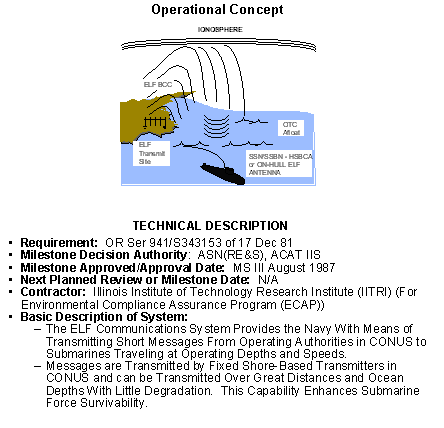





The ELF frequency range is critically important to the Navy because of its value in providing a way to communicate with submerged submarines. As a result of the high electrical conductivity of sea water, signals are attenuated rapidly as they propagate downward through it. In effect, the sea water "hides" the submarine from detection while simultaneously preventing it from communicating with the outside world through normal radio transmissions.
The degree to which a signal is attenuated depends on its frequency, however. The lower the frequency, the more deeply a signal can be received in sea water. In order to receive conventional radio transmissions a submarine must travel at slow speeds and be near the surface of the water. Both of these situations make a submarine more susceptible to enemy detection. Frequencies in the ELF range, however, can be received considerably deeper, and broadcasts using this mode provide a primary link between the nation's commander-in-chief and the submarine force. One of the great difficulties associated with the use of ELF for communication purposes, is the problem of generating a useful signal. The physical size of an antenna that can produce a useable signal with reasonable efficiency is inversely proportional to the frequency. For example, an antenna useful for cellular telephone frequencies, need only be several inches long to be completely effective. At ELF, on the other hand, a reasonably efficient antenna must be quite large. The US Navy extremely low frequency [40-80Hz] experiment Project Sanguine installed a 222km pole mounted dipole antenna high up in the Laurentian Shield in Wisconsin - upgraded to the 45km Project Seafarer antenna at Clam Lake, Wisconsin. Following an unsucessful standoff between environmental lobbyists and Ronald Reagan in 1981 a futher Seafarer upgrade featuring 90km wires was installed KI Sawyer Air Force Base, Michigan, incorporating operational VLF into the integrated C3i program of the American Department of Defense. VLF links between the Wisconsin station & submarine receivers in the Pacific were established in May 1985, followed by transmissions to beneath the Mediterranean Sea and Northern Polar Ice Cap.Extremely low frequency continues to be an essential communications system to support strategic and tactical submarine forces. Both strategic and attack submarine commanders are making operational use of extremely low frequency capabilities supported at both ELF sites.
The ELF system is the only system capable of providing continuous communications to submarines operating at designed depths and speeds. Without ELF, strategic submarines would be limited to operations at much slower speeds and at significantly shallower depths, severely restricting maneuverability and training. Similarly, attack submarines operating in support of battle group commanders would be restricted without the connectivity provided by ELF.


